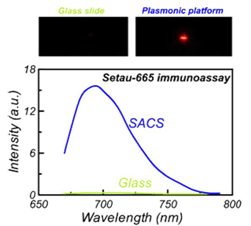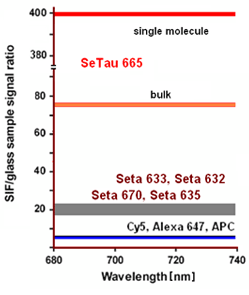- Home »
- Applications »
- Plasmonics
Plasmonics
Seta and SeTau dyes exhibit larger sensitivity enhancements than any other type of dyes on plasmonic platforms.
| Excitation Light Sources | Characteristics | ||||||||||||||||||||
| Product Number (Specs Sheet) |
Product Name (Product Info) |
Target Group | 380 | 405 | 436 | 488 | 532 | 594 | 635 | 650 | 680 | 700 | 750 | 780 | Medium | λ abs [nm] |
ε [M –1 cm–1] |
λ em [nm] |
QY [%] |
FLT [ns] |
Buy |
| K8-1342 | Seta-670-NHS | NH2 | • | • | • | • | PB 7.4 | 667 | 180,000 | 688 | 7 | 0.42 | |||||||||
| K8-1642 | Seta-632-NHS | NH2 | • | PB 7.4 | 632 | 280,000 | 641 | 6 | |||||||||||||
| K8-1663 | Seta-633-NHS | NH2 | • | • | PB 7.4 | 633 | 250,000 | 644 | 7 | 0.25 | |||||||||||
| K9-4119 new | SeTau-665-NHS | NH2 | • | • | • | PB 7.4 | 664 | 160,000 | 712 | 53 | 3.1 | ||||||||||
| K9-4142 | SeTau-647-di-NHS | NH2 | • | • | PB 7.4 | 650 | 200,000 | 694 | 65 | 3.2 | |||||||||||
| K9-4149 | SeTau-647-NHS | NH2 | • | • | PB 7.4 | 649 | 200,000 | 695 | 61 | 3.2 | |||||||||||
| K8-1341 | Seta-670-Maleimide | SH | • | • | • | • | PB 7.4 | 667 | 180,000 | 688 | 7 | ||||||||||
Metal Enhanced Fluorescence (MEF)
Metal-enhanced fluorescence (MEF) is an important approach to increase the sensitivity thereby decreasing the detection limit of biomedical assays. There are two contributions to MEF. Firstly, under the influence of the incident light, the molecule goes to the excited state and interacts with the metal. Secondly, metal particles accelerate the fluorophore’s radiative decay rate and as a result enhance the emission. This emitter-antenna-like effect results in an increase of the quantum yield of the molecule and in a decrease of its lifetime. A simultaneous increase of the quantum yield and decrease of the lifetime is only possible when the radiative rate increases. Therefore this effect is also known as radiative decay engineering (RDE). While typical enhancement levels for conventional dyes on plasmonic platforms are in the order of 5-7-fold, SeTau-665 shows a 70-fold enhancement in ensemble measurements (Figure) and up to 400-fold in certain ‘hot spots’ in single molecule measurements [16]. Such enhancement levels have not been observed with any other type of dyes.

Due to the large enhancements in single molecule (SM) level measurements, SM studies which were previously impossible can be successfully performed on such plasmonic platforms using SeTau dyes.
The large increase in brightness allows the reduction of the excitation power resulting in a reduced background and increased photostability. The remarkable fluorescence enhancements observed for SeTau dyes on plasmonic platform substantially improves single molecule detection and reduces the detection limits in sensing devices.
|
Seta and SeTau dyes show much higher signal enhancement (SE) on silver surfaces (SIFs) compared to fluorophores such as Cy5, Alexa 647 or phycobiliproteins (PE, APC):

SIF-coated vs. non-coated glass fluorescence signal ratio at various wavelengths tested in a model immunoassay for SeTau dyes (SE ~ 70 times in bulk and SE ~ 400 times in single molecule measurements), Seta-670-NHS, Seta-633-NHS or Seta-632-NHS (SE ~ 15 – 20 times) vs. Cy5, Alexa 647 or APC (SE ~ 6 - 7 times).
| Product Number (Specs Sheet) |
Product Name (Product Info) |
|---|---|
| K8-1342 | Seta-670-NHS |
| K8-1663 | Seta-633-NHS |
| K8-1642 | Seta-632-NHS |

